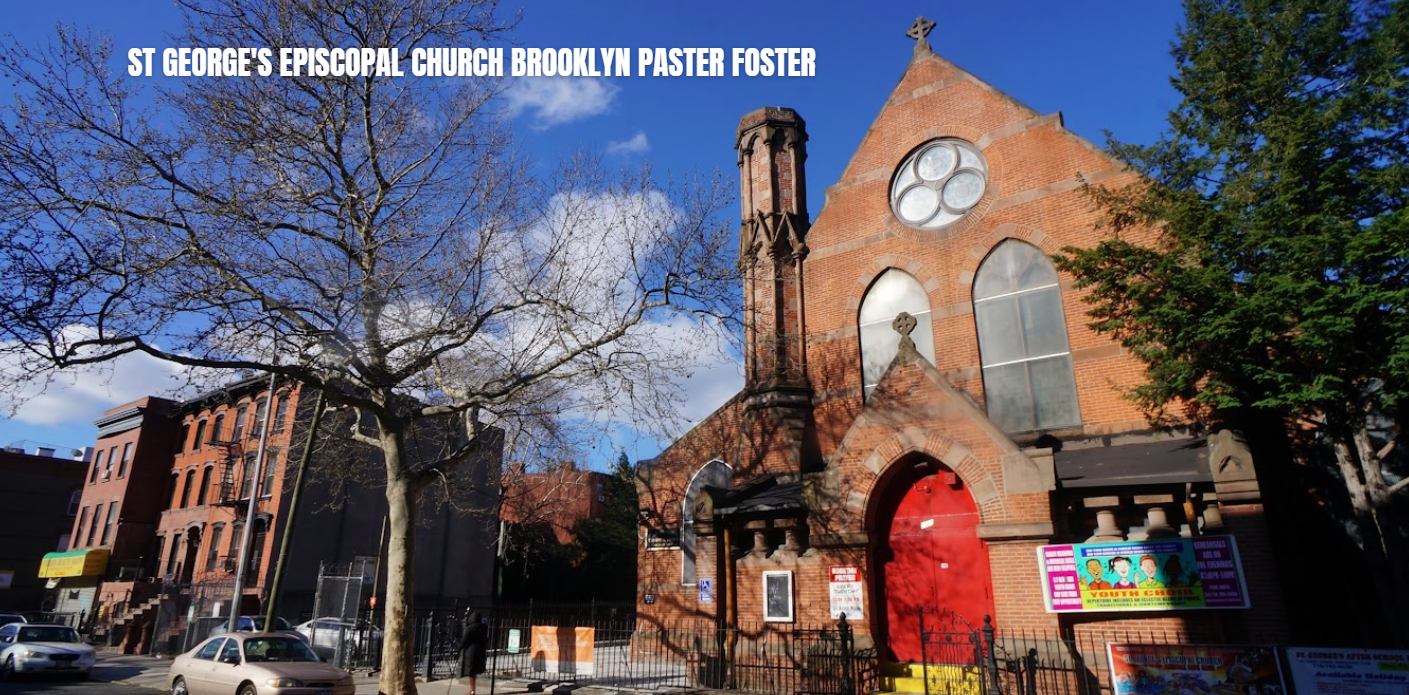St. George’s Episcopal Church Brooklyn Pastor Foster: A Beacon of Faith and Community
St. George’s Episcopal Church in Brooklyn, located at 800 Marcy Avenue in the vibrant Bedford-Stuyvesant neighborhood, has long stood as a symbol of faith, resilience, and community.
With a rich history that dates back to the 19th century, this historic church has not only served as a spiritual home to generations of worshippers but has also played an essential role in shaping the social and cultural fabric of the neighborhood.
One of the church’s most influential and beloved leaders is Pastor Foster, whose leadership has helped the congregation flourish in both spiritual growth and community service.
The Historical Significance of St. George’s Episcopal Church
St. George’s Episcopal Church, also referred to as St. George’s Anglican Church, has a history that stretches back more than 150 years. It was founded during a period when Brooklyn was emerging as a key center for commerce, arts, and culture in New York City. Built in 1887, this Gothic Revival-style church was designed by renowned architect Richard Upjohn, whose work continues to be celebrated for its contribution to the ecclesiastical architecture of the United States.
St. George’s is more than just an architectural gem. Throughout its history, it has served as a religious sanctuary for people from all walks of life. The church played a critical role in the spiritual and social lives of its congregation during times of social upheaval, economic challenges, and racial tensions in the country. Even today, St. George’s remains a steadfast pillar of faith in Bedford-Stuyvesant, providing spiritual guidance, community support, and a sense of belonging to its members.
The Church’s Role in Bedford-Stuyvesant’s Growth
Bedford-Stuyvesant, often referred to as “Bed-Stuy,” is one of the most culturally significant neighborhoods in New York City. Historically, the area has been home to a large African American population and has produced some of the city’s most iconic figures in music, arts, and activism.
Throughout the neighborhood’s transformation, from a middle-class enclave in the 19th century to its prominence in the civil rights movement and beyond, St. George’s Episcopal Church has been at the forefront of community engagement. The church has provided essential services such as food pantries, educational programs, and support for the homeless, fostering a deep connection with the residents of the neighborhood.
Pastor Foster, with his visionary leadership, has carried on this legacy, reinforcing the church’s role as a haven for spiritual growth and social justice. Under his guidance, the church has expanded its outreach efforts, further ingraining itself in the fabric of Bedford-Stuyvesant’s diverse community.
Who is Pastor Foster?
Pastor Foster is the heart and soul of St. George’s Episcopal Church. Known for his passionate sermons, compassionate leadership, and unwavering commitment to social justice, he has become a beloved figure not only within the congregation but also in the broader Brooklyn community.
Pastor Foster’s ministry goes beyond traditional religious services. His work emphasizes inclusivity, bridging divides across races, generations, and social classes. Under his leadership, St. George’s has seen a revitalization in both its membership and its community initiatives. He has successfully embraced the challenges of modern-day ministry, using innovative approaches to ensure that the church remains relevant in an ever-changing society.
Pastor Foster’s Vision for the Church
At the core of Pastor Foster’s vision is the belief that faith must be lived through action. He encourages his congregation to engage with the world around them, embodying Christian values not only through worship but also through community service and activism. His sermons often emphasize themes of equality, justice, and love—principles that resonate deeply with the congregation and the wider community.
One of his key initiatives has been expanding the church’s outreach programs. Pastor Foster has worked tirelessly to strengthen partnerships with local organizations, ensuring that St. George’s remains a key resource for those in need. Whether through feeding programs, job training, or mental health counseling, the church has become a lifeline for many under Pastor Foster’s leadership.
The Spiritual and Social Impact of St. George’s Episcopal Church Under Pastor Foster
Pastor Foster’s tenure at St. George’s Episcopal Church has brought about a renewed sense of purpose within the congregation. His focus on inclusivity, social justice, and community service has had a profound impact on both the church and its surrounding neighborhood.
1. Strengthening Community Bonds
Pastor Foster’s leadership has fostered stronger bonds among congregants and with the broader Brooklyn community. His inclusive approach has attracted people from diverse backgrounds, creating a melting pot of cultures, ideas, and experiences. The church hosts events and gatherings that bring people together, regardless of race, ethnicity, or socio-economic status, reinforcing the idea that the church is a place where all are welcome.
2. Promoting Social Justice
One of the hallmarks of Pastor Foster’s leadership is his unwavering commitment to social justice. He believes that the church should be a force for positive change in the world, and he encourages his congregation to stand up for the oppressed, advocate for equality, and fight against injustice. His sermons often touch on contemporary issues such as racial inequality, poverty, and access to healthcare, urging his followers to be active participants in the fight for a fairer society.
3. Innovative Ministry in the Digital Age
Recognizing the importance of technology in today’s world, Pastor Foster has embraced digital tools to enhance the church’s reach and relevance. During the COVID-19 pandemic, St. George’s quickly transitioned to online services, allowing congregants to continue practicing their faith despite social distancing measures. Pastor Foster also launched virtual Bible study groups and prayer meetings, ensuring that the church remained a source of comfort and connection during a difficult time.
In addition to online worship, the church uses social media to engage with the community, share important messages, and promote events. This digital presence has allowed St. George’s to extend its influence beyond Bedford-Stuyvesant, attracting followers from across Brooklyn and even beyond New York City.
4. Empowering the Next Generation
Pastor Foster is deeply committed to the empowerment of youth. Through various youth programs, the church provides mentorship, education, and leadership opportunities to the next generation. Pastor Foster believes that the future of the church lies in the hands of young people, and he works to inspire them to become active participants in their faith and community.
The Architecture and Cultural Legacy of St. George’s Episcopal Church
St. George’s Episcopal Church is not just a place of worship; it is an architectural masterpiece. Built in the Gothic Revival style, the church features intricate stained-glass windows, vaulted ceilings, and a soaring bell tower that has become an iconic part of the Bedford-Stuyvesant skyline.
The church’s architecture serves as a reminder of its long history and the generations of worshippers who have passed through its doors. It has been designated a historic landmark, preserving its legacy for future generations. Beyond its physical beauty, St. George’s Episcopal Church represents the enduring spirit of faith and community that continues to thrive within its walls.
The Church as a Cultural Hub
Throughout its history, St. George’s has been more than just a religious institution; it has been a cultural hub for the neighborhood. The church has hosted countless events, from concerts and art exhibitions to community meetings and educational workshops. These events have helped to strengthen the church’s ties to the community and have made it a central gathering place for people from all walks of life.
Under Pastor Foster’s leadership, the church continues to serve as a space for artistic and cultural expression. The church’s music ministry, in particular, has gained recognition for its powerful performances, blending traditional hymns with contemporary gospel music. The music not only enhances the worship experience but also serves as a source of inspiration for the community.
The Future of St. George’s Episcopal Church Brooklyn Pastor Foster
As St. George’s Episcopal Church looks to the future, it remains committed to its mission of serving both the spiritual and social needs of its congregation and community. Pastor Foster’s leadership will undoubtedly continue to play a pivotal role in guiding the church through the challenges and opportunities of the 21st century.
A Vision for Growth
Pastor Foster’s vision for the future includes expanding the church’s outreach programs and strengthening its role as a community leader in Bedford-Stuyvesant. He is passionate about addressing the systemic issues that affect the neighborhood, such as poverty, unemployment, and housing insecurity. Through partnerships with local organizations and city agencies, he hopes to create lasting change that will benefit future generations.
At the same time, Pastor Foster remains committed to nurturing the spiritual growth of the congregation. He continues to encourage members to deepen their faith, engage in meaningful worship, and live out their Christian values in their daily lives.
FAQs About St. George’s Episcopal Church Brooklyn Pastor Foster
1. What makes St. George’s Episcopal Church a historic landmark?
St. George’s Episcopal Church is a historic Gothic Revival church designed by architect Richard Upjohn. Its architectural significance, combined with its role in the community for over 150 years, has earned it landmark status in Brooklyn.
2. Who is Pastor Foster, and what is his role at the church?
Pastor Foster is the leader of St. George’s Episcopal Church. He is known for his passionate sermons, dedication to social justice, and commitment to serving both the congregation and the broader Brooklyn community.
3. What community programs does St. George’s offer?
St. George’s offers a variety of community programs, including food pantries, educational workshops, mental health counseling, youth mentorship, and more. The church also partners with local organizations to address issues such as homelessness and unemployment.
4. How has St. George’s adapted to the digital age?
Under Pastor Foster’s leadership, the church has embraced digital tools to enhance its outreach. This includes online worship services, virtual Bible study groups, and active social media engagement to connect with the community.
5. What is Pastor Foster’s vision for the future of the church?
Pastor Foster’s vision includes expanding the church’s outreach efforts, continuing its mission of social justice, and nurturing the spiritual growth of its congregation. He hopes to further strengthen the church’s role as a community leader in Bedford-Stuyvesant.
Conclusion
St. George’s Episcopal Church, under the leadership of Pastor Foster, is a powerful force for good in Brooklyn’s Bedford-Stuyvesant neighborhood. With its rich history, commitment to social justice, and dynamic approach to modern ministry, St. George’s continues to inspire and uplift those it serves.
Pastor Foster’s vision for inclusivity, community engagement, and spiritual growth ensures that the church will remain a beacon of hope for generations to come.







